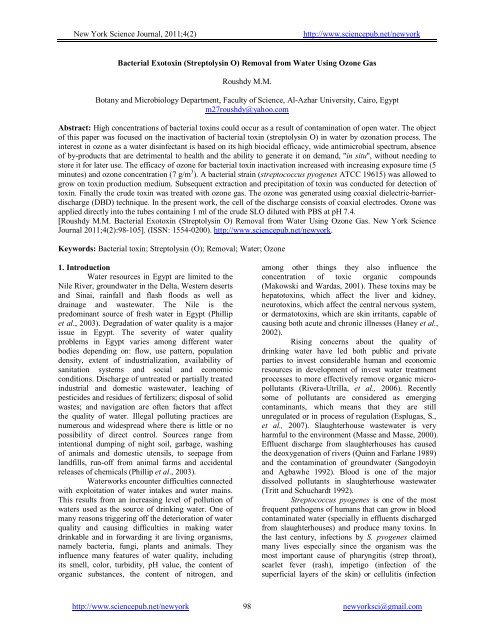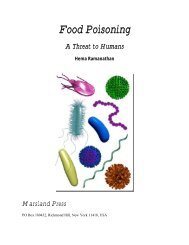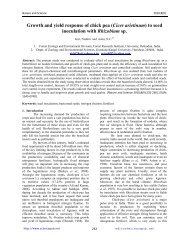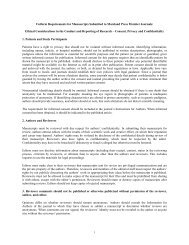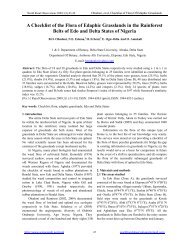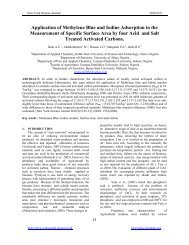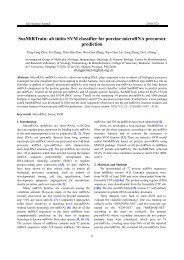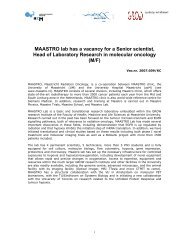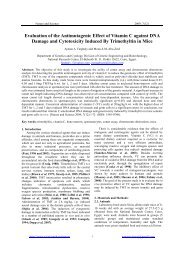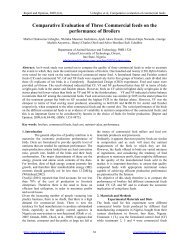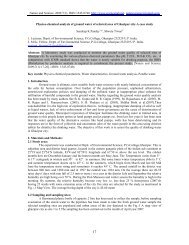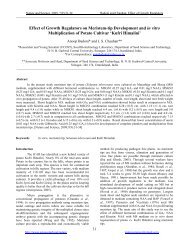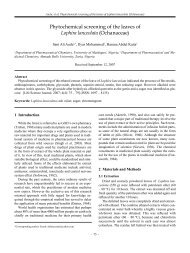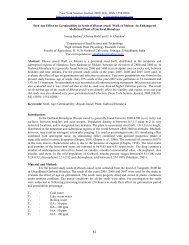Bacterial Exotoxin (Streptolysin O) Removal from Water Using
Bacterial Exotoxin (Streptolysin O) Removal from Water Using
Bacterial Exotoxin (Streptolysin O) Removal from Water Using
Create successful ePaper yourself
Turn your PDF publications into a flip-book with our unique Google optimized e-Paper software.
New York Science Journal, 2011;4(2) http://www.sciencepub.net/newyork<br />
<strong>Bacterial</strong> <strong>Exotoxin</strong> (<strong>Streptolysin</strong> O) <strong>Removal</strong> <strong>from</strong> <strong>Water</strong> <strong>Using</strong> Ozone Gas<br />
Roushdy M.M.<br />
Botany and Microbiology Department, Faculty of Science, Al-Azhar University, Cairo, Egypt<br />
m27roushdy@yahoo.com<br />
Abstract: High concentrations of bacterial toxins could occur as a result of contamination of open water. The object<br />
of this paper was focused on the inactivation of bacterial toxin (streptolysin O) in water by ozonation process. The<br />
interest in ozone as a water disinfectant is based on its high biocidal efficacy, wide antimicrobial spectrum, absence<br />
of by-products that are detrimental to health and the ability to generate it on demand, ''in situ'', without needing to<br />
store it for later use. The efficacy of ozone for bacterial toxin inactivation increased with increasing exposure time (5<br />
minutes) and ozone concentration (7 g/m 3 ). A bacterial strain (streptococcus pyogenes ATCC 19615) was allowed to<br />
grow on toxin production medium. Subsequent extraction and precipitation of toxin was conducted for detection of<br />
toxin. Finally the crude toxin was treated with ozone gas. The ozone was generated using coaxial dielectric-barrierdischarge<br />
(DBD) technique. In the present work, the cell of the discharge consists of coaxial electrodes. Ozone was<br />
applied directly into the tubes containing 1 ml of the crude SLO diluted with PBS at pH 7.4.<br />
[Roushdy M.M. <strong>Bacterial</strong> <strong>Exotoxin</strong> (<strong>Streptolysin</strong> O) <strong>Removal</strong> <strong>from</strong> <strong>Water</strong> <strong>Using</strong> Ozone Gas. New York Science<br />
Journal 2011;4(2):98-105]. (ISSN: 1554-0200). http://www.sciencepub.net/newyork.<br />
Keywords: <strong>Bacterial</strong> toxin; <strong>Streptolysin</strong> (O); <strong>Removal</strong>; <strong>Water</strong>; Ozone<br />
1. Introduction<br />
<strong>Water</strong> resources in Egypt are limited to the<br />
Nile River, groundwater in the Delta, Western deserts<br />
and Sinai, rainfall and flash floods as well as<br />
drainage and wastewater. The Nile is the<br />
predominant source of fresh water in Egypt (Phillip<br />
et al., 2003). Degradation of water quality is a major<br />
issue in Egypt. The severity of water quality<br />
problems in Egypt varies among different water<br />
bodies depending on: flow, use pattern, population<br />
density, extent of industrialization, availability of<br />
sanitation systems and social and economic<br />
conditions. Discharge of untreated or partially treated<br />
industrial and domestic wastewater, leaching of<br />
pesticides and residues of fertilizers; disposal of solid<br />
wastes; and navigation are often factors that affect<br />
the quality of water. Illegal polluting practices are<br />
numerous and widespread where there is little or no<br />
possibility of direct control. Sources range <strong>from</strong><br />
intentional dumping of night soil, garbage, washing<br />
of animals and domestic utensils, to seepage <strong>from</strong><br />
landfills, run-off <strong>from</strong> animal farms and accidental<br />
releases of chemicals (Phillip et al., 2003).<br />
<strong>Water</strong>works encounter difficulties connected<br />
with exploitation of water intakes and water mains.<br />
This results <strong>from</strong> an increasing level of pollution of<br />
waters used as the source of drinking water. One of<br />
many reasons triggering off the deterioration of water<br />
quality and causing difficulties in making water<br />
drinkable and in forwarding it are living organisms,<br />
namely bacteria, fungi, plants and animals. They<br />
influence many features of water quality, including<br />
its smell, color, turbidity, pH value, the content of<br />
organic substances, the content of nitrogen, and<br />
among other things they also influence the<br />
concentration of toxic organic compounds<br />
(Makowski and Wardas, 2001). These toxins may be<br />
hepatotoxins, which affect the liver and kidney,<br />
neurotoxins, which affect the central nervous system,<br />
or dermatotoxins, which are skin irritants, capable of<br />
causing both acute and chronic illnesses (Haney et al.,<br />
2002).<br />
Rising concerns about the quality of<br />
drinking water have led both public and private<br />
parties to invest considerable human and economic<br />
resources in development of invest water treatment<br />
processes to more effectively remove organic micropollutants<br />
(Rivera-Utrilla, et al., 2006). Recently<br />
some of pollutants are considered as emerging<br />
contaminants, which means that they are still<br />
unregulated or in process of regulation (Esplugas, S.,<br />
et al., 2007). Slaughterhouse wastewater is very<br />
harmful to the environment (Masse and Masse, 2000).<br />
Effluent discharge <strong>from</strong> slaughterhouses has caused<br />
the deoxygenation of rivers (Quinn and Farlane 1989)<br />
and the contamination of groundwater (Sangodoyin<br />
and Agbawhe 1992). Blood is one of the major<br />
dissolved pollutants in slaughterhouse wastewater<br />
(Tritt and Schuchardt 1992).<br />
Streptococcus pyogenes is one of the most<br />
frequent pathogens of humans that can grow in blood<br />
contaminated water (specially in effluents discharged<br />
<strong>from</strong> slaughterhouses) and produce many toxins. In<br />
the last century, infections by S. pyogenes claimed<br />
many lives especially since the organism was the<br />
most important cause of pharyngitis (strep throat),<br />
scarlet fever (rash), impetigo (infection of the<br />
superficial layers of the skin) or cellulitis (infection<br />
http://www.sciencepub.net/newyork 98<br />
newyorksci@gmail.com
New York Science Journal, 2011;4(2) http://www.sciencepub.net/newyork<br />
of the deep layers of the skin). Invasive, toxigenic<br />
infections can result in necrotizing facilities, myositis<br />
and streptococcal toxic shock syndrome. Patients<br />
may also develop immune-mediated poststreptococcal<br />
infection, such as acute rheumatic fever<br />
and acute glomerulonephritis, following acute<br />
infections caused by Streptococcus pyogenes<br />
(Kenneth Todar,2008).<br />
Endotoxin and exotoxins are examples of<br />
organic micro-pollutants that has several adverse<br />
health effects for human (Rapala et al., 2002).<br />
Endotoxin are typically released either during cell<br />
lyses or multiplication and have a high stability even<br />
at high temperature (stable at 121ºC for 1 h) and pH<br />
values due to its amphoteric structure (Hyrayama et<br />
al., 1999; Anderson et al., 2003). General symptoms<br />
of endotoxin exposure in humans include fever,<br />
diarrhea, vomiting, hypotensions, shock,<br />
intravascular coagulation and death (Tessarolo et al.,<br />
2006). To date, outbreaks of endotoxin-related illness<br />
associated with drinking water have been<br />
documented infrequently. This may be due to the<br />
facts that outbreaks of fever-related illness in water<br />
are never identified by routine medical and<br />
bacteriological analyses and since endotoxin related<br />
fevers symptoms are typically short-lived (Anderson<br />
et al., 2003). Rezaee et al., (2008) studied the<br />
inactivation of endotoxin in water by ozonation<br />
process.<br />
Klaus (2009) indicated that exotoxins are<br />
toxic proteins that are secreted by many<br />
microorganisms. The have a high toxicity and they<br />
are heat labile. Many exotoxins consist of an A part<br />
and a B part. The A part has the enzymatic activity<br />
whereas the B part binds the toxin to the tissue cell<br />
and translocated the A part across the tissue cell<br />
membrane into the cytoplasm. One of the most<br />
important exotoxins is streptolysin (haemolysin)<br />
which acts by destroying membrane phospholipids.<br />
<strong>Streptolysin</strong> 0 (SLO) belongs to a family of<br />
cytolysins produced by four genera of gram-positive<br />
bacteria, Streptococcus, Bacillus, Clostridium, and<br />
Listeria, most of which are pathogenic for humans<br />
(Dieter et al., 1993). <strong>Streptolysin</strong> O (SLO) is a potent<br />
membrane-disrupting protein produced by<br />
Streptococcus pyogenes, and it has been reported to<br />
bind to cholesterol in the red blood cell membrane,<br />
form polymers, and generate very large transmembrane<br />
channels, through which haemoglobin (Hb)<br />
can escape (Jun Suzuki, 2009).<br />
There are several ways in which endotoxin<br />
can be detoxified but, <strong>from</strong> the point of view of<br />
drinking water treatment, oxidation with hydrogen<br />
peroxide or permanganate is of most interest.<br />
Although application of these compounds is the most<br />
important method but control of required dosage of<br />
oxidants, safety of operators, storage problems and<br />
control of their by products are difficult (Anderson et<br />
al., 2002). Recently water purification with ozone as<br />
an option to disinfection and degrade organic<br />
micropollutants has been widely developed (Smeets<br />
et al., 2006; Sano et al., 2007). Ozonation is the dark<br />
oxidation method can be used in the removal of new<br />
emergent pollutants. Approximately 90% of dark<br />
oxidation treatments found in the scientific literature<br />
corresponds to ozonation (Esplugas et al., 2007).<br />
Because, this process has several advantages as<br />
follows: reactivity of ozone is quite strong so that<br />
organic compounds can be degraded effectively,<br />
ozone can be generated easily by use of ultraviolet<br />
light or electric discharge and can be converted to O2<br />
easily (Sano et al., 2007).<br />
2. Material and Methods<br />
2.1. Strain<br />
The strain S. pyogenes ATCC 19615 (group<br />
A) was obtained kindly <strong>from</strong> the department of<br />
microbiology , Memphis Pharmaceutical Company<br />
(Cairo, Egypt). The strain was maintained on nutrient<br />
agar slants at 4 ºC.<br />
2.2. Culture medium<br />
The reference strain (S. pyogenes ATCC<br />
19615) was cultivated on Mueller–Hinton broth<br />
supplemented with 3–5% rabbit blood (Steininger et<br />
al., 2002), and incubated at 37°C for 7 to 8 hours to<br />
be used in the preparation of crude streptolysin O<br />
toxin.<br />
2.3. Preparation of crude streptolysin O (SLO)<br />
toxin<br />
One liter of cultivation medium was<br />
inoculated with 5 ml of bacterial suspension cultured<br />
for 7 to 8 h, and incubated at 37°C with shaking, the<br />
pH was held at 7.5 for 16 to 18 h of incubation. After<br />
incubation, culture supernatants were harvested by<br />
centrifugation at 12000 rpm for 15 minutes (Jun<br />
Suzuki, 2009).<br />
2.4. Precipitation of crude streptolysin (O) toxin<br />
The supernatants fluid containing SLO toxin<br />
were brought to 0, 20, 40, 60, 80 and 100 %<br />
saturation by the addition of solid ammonium sulfate.<br />
The precipitates were recovered by centrifugation,<br />
collected in approximately 100 ml and stored at 4 ºC<br />
and spiked as a target pollutant to water for<br />
producing of identified concentration of 200 IU/ml<br />
(Grushoff et al, 1975).<br />
2.5. Assay of SLO hemolytic activity<br />
Hemolytic activity of SLO was<br />
spectrophotometrically determined using 50% end-<br />
http://www.sciencepub.net/newyork 99<br />
newyorksci@gmail.com
New York Science Journal, 2011;4(2) http://www.sciencepub.net/newyork<br />
point titration (Jun Suzuki, 2009). SLO preparations<br />
were diluted with Phosphate buffered saline (PBS)<br />
supplemented with 2-mercaptoethanol (2-ME) and<br />
bovine serum albumin (BSA), and 0.5 ml of a 2.5%<br />
suspension of rabbit erythrocytes (RE) in PBS (pH<br />
7.4) was added to 1.5 ml of the SLO solutions. After<br />
incubation at 37°C for 60 min, tubes were centrifuged<br />
and supernatant (containing haemoglobin) in the<br />
tubes was measured spectrophotometrically at 510<br />
nm against a blank tube containing the diluent in<br />
stead of SLO. One hemolytic unit is defined as the<br />
smallest amount of streptolysin required to produce<br />
50% lysis of 1 ml of a 2.5% of rabbit erythrocytes<br />
suspension upon incubation at 37 ºC for 60 min<br />
(Grushoff et al., 1975). Calibration curve (Fig. 2) was<br />
plotted with using of standard exotoxin SLO (Sigma<br />
No., S5265, USA) with concentration of 25.000 –<br />
50.000 U/vial. Hemolysis percentage as well as<br />
optical densities of SLO standard (200 U/ml) at<br />
different doses (μl/ml) were used (Table 1) and a<br />
standard curve was constructed between log of SLO<br />
doses and hemolysis percentage where a linear<br />
relationship was obtained.<br />
2.6. Protein estimation<br />
Protein in the supernatants was estimated by<br />
the method of Lowry et al, (1951), and determined at<br />
absorbance of 280 nm. Comparison was made with a<br />
standard curve of bovine albumin.<br />
2.7. Ozone generation and treatment<br />
In the present work, the cell of the discharge<br />
consists of coaxial electrodes (Fig. 1), the inner<br />
electrode is made of brass with radius (0.5 cm) and<br />
the outer electrode is made of graphite coating on the<br />
outer wall of a glass tube. The dielectric material<br />
between the two electrodes is Pyrex glass of 0.1 cm<br />
thickness. The gap space between the inner electrode<br />
and the inner wall of glass tube is 0.2 cm. The length<br />
of the reactor region is 50 cm and the gas pressure<br />
used is 1.005 bar. The working gas is pure oxygen<br />
(99.9%) and the gas flow rate was adjusted to 5<br />
L/min (Garamoon et al., 2009). Ozone was applied<br />
directly into tubes containing 1 ml of the crude SLO<br />
diluted with PBS at pH 7.4.<br />
Glass Aquadag<br />
Cu<br />
O 2 O 3<br />
L<br />
Figure 1. Schematic of the dielctric coaxial electrodes<br />
V<br />
A<br />
3. RESULTS<br />
3.1. Construction of a standard curve for assaying<br />
of the standard SLO toxin<br />
As shown in Table (1), different doses of a<br />
standard SLO (Sigma, USA) showed varying<br />
hemolysis percentages. One hundred % of hemolysis<br />
was achieved at 1.7 log doses of SLO (45 μl/ml) of<br />
200 U/ml of SLO standard with an optical density<br />
(O.D.) of 0.59 g/l (hemolysed rabbit erythrocytes) at<br />
510 nm. Results also revealed that a linear<br />
relationship was obtained (Fig.2).<br />
Figure 2. A linear relationship between log doses of<br />
SLO and optical densities of supernatants at 510 nm<br />
Table 1. relation between different SLO doses,<br />
hemolysis (%) and their optical densities<br />
SLO doses<br />
(μl/ml)<br />
Log dose<br />
of SLO<br />
Hemolysis<br />
%<br />
http://www.sciencepub.net/newyork 100<br />
newyorksci@gmail.com<br />
O.D.<br />
at 510<br />
nm<br />
(g/l)<br />
1.50 0.1 8 0.05<br />
2.00 0.2 17 0.10<br />
3.00 0.5 31 0.18<br />
6.00 0.7 42 0.25<br />
9.00 0.9 54 0.32<br />
13.0 1.1 68 0.40<br />
18.0 1.3 76 0.45<br />
30.0 1.5 88 0.52<br />
45.0 1.7 100 0.59
New York Science Journal, 2011;4(2) http://www.sciencepub.net/newyork<br />
3.2. Precipitation of crude SLO produced by S.<br />
pyogenes ATCC 19615<br />
As can be seen <strong>from</strong> Table (2), the crude<br />
SLO produced by the cultivation of the reference<br />
strain S. pyogenes ATCC 19615 on the production<br />
medium showed a maximum hemolytic activity with<br />
an optical density of 0.59 g/l at 80 % ammonium<br />
sulphate fractionation (Fig. 3). The protein content<br />
was estimated for each fraction.<br />
Table 2. Ammonium sulphate fractionation of crude<br />
SLO produced by S. pyogenes ATCC 19615<br />
Ammonium<br />
sulphate<br />
conc. (%)<br />
Protein content (mg/ml)<br />
14<br />
12<br />
10<br />
8<br />
6<br />
4<br />
2<br />
Protein<br />
content<br />
(mg/ml)<br />
O.D. of<br />
supernatant<br />
at 510 (nm)<br />
0 4.5 0.11<br />
20 7.3 0.29<br />
40 9.5 0.34<br />
60 10.6 0.46<br />
80 12.7 0.59<br />
100 12.6 0.59<br />
0<br />
0 20 40 60 80 100 120<br />
Ammonium sulphate conc. (%)<br />
Figure 3. Precipitation of crude SLO produced by S.<br />
pyogenes ATCC 19615 using different ammonium<br />
sulphate concentrations<br />
3.3. Effect of ozone on different concentrations of<br />
crude SLO<br />
Different doses of crude SLO (i.e. 2.5, 5, 15,<br />
30 and 45) with concentration of 200 IU/ml were<br />
exposed to 1 g/m 3 ozone at 37 ºC for 1 min Table (3).<br />
An obvious decrease in hemolytic activity of crude<br />
SLO was detected when compared with the results of<br />
the control (untreated). Data were illustrated and<br />
represented in Fig (4).<br />
Table 3. Effect of 1 g/m 3 ozone on different doses of<br />
crude SLO at 37 ºC for 1 min<br />
Doses<br />
of<br />
crude<br />
SLO<br />
(μl/ml)<br />
Log<br />
doses<br />
of SLO<br />
(μl/ml)<br />
Treated SLO Untreated SLO<br />
http://www.sciencepub.net/newyork 101<br />
newyorksci@gmail.com<br />
O.D.<br />
(g/l)<br />
Hemolysis<br />
(%)<br />
O.D<br />
(g/l)<br />
Hemolysis<br />
(%)<br />
45 1.7 0.37 64 0.58 100<br />
30 1.5 0.35 60 0.50 86<br />
15 1.2 0.27 47 0.43 74<br />
5 0.7 UD* UD 0.23 40<br />
2.5 0.4 UD UD 0.15 26<br />
* UD = Undetected<br />
Hemolysis (%)<br />
120<br />
100<br />
80<br />
60<br />
40<br />
20<br />
0<br />
0.1 0.2 0.3 0.4 0.5 0.6 0.7 0.8 0.9 1 1.1 1.2 1.3 1.4 1.5 1.6 1.7 1.8<br />
Log doses of SLO (ul/ml)<br />
Treated<br />
Untreated<br />
Figure 4. Exposure of different doses of crude SLO<br />
to 1 g/m 3 ozone for 1 min at 37 ºC<br />
3.4. Effect of different ozone concentrations on<br />
crude SLO<br />
An appropriate dose (45 μl/ml) of crude<br />
SLO (200 U/ml) was exposed to different ozone<br />
concentrations (i.e. 1, 3, 5, 7 and 9 g/m 3 for a defined
New York Science Journal, 2011;4(2) http://www.sciencepub.net/newyork<br />
time (1 min) at 37 ºC. Results recorded in table (4)<br />
and represented graphically in figure (5) revealed that<br />
there was a continuous decrease in percentage of<br />
hemolysis due to increasing of ozone concentrations.<br />
Both of hemolysis as well as optical densities of the<br />
crude SLO supernatant were undetected at ozone<br />
concentrations of 7 and 9 g/m 3 respectively.<br />
Table 4. Inactivation of crude SLO by different<br />
Ozone Concentrations for 1 min at 37 ºC<br />
*UD= Undetected<br />
O.D. at 510 nm (g/l)<br />
Ozone<br />
Conc.<br />
(g/m 3 )<br />
0.7<br />
0.6<br />
0.5<br />
0.4<br />
0.3<br />
0.2<br />
0.1<br />
0<br />
Hemolysis<br />
(%)<br />
O.D. at 510 nm<br />
(g/l)<br />
0 100 0.59<br />
1 59 0.35<br />
3 36 0.21<br />
5 14 0.08<br />
7 UD * UD<br />
9 UD UD<br />
0 2 4 6 8 10<br />
Ozone conc. (g/m 3 )<br />
Figure 5. Crude SLO inactivation by different conc.<br />
Of ozone for 1 min at 37 ºC<br />
3.5. Inactivation of crude SLO in relation to time<br />
of ozone exposure<br />
The crude SLO (200 U/ml) was exposed to 1<br />
g/m 3 ozone at specific dose 45 (μl/ml) for various<br />
exposure times (0, 1, 2, 3, 4, 5 and 6 min) at 37 ºC.<br />
The represented data (Fig. 6) showed that by<br />
increasing the time of ozone exposure, the optical<br />
density of the studied samples decreases. Hemolysis<br />
was found to be disappeared at 5 min of ozone<br />
exposure (Table 5).<br />
Table 5. Effect of different exposure times on The<br />
activity of crude SLO<br />
Exposure<br />
time (min)<br />
* UD = Undetected<br />
Hemolysis<br />
(%)<br />
O.D. at 510 nm<br />
(g/l)<br />
0 100 0.59<br />
1 59 0.35<br />
2 49 0.29<br />
3 29 0.17<br />
4 12 0.07<br />
5 UD* UD<br />
6 UD UD<br />
Figure 6. Inactivation of crude SLO in relation to<br />
increasing of Ozone exposure time<br />
4. DISCUSSION<br />
This study was focused on bacterial toxin<br />
removal during drinking water treatment with the<br />
primary focus on the removal of extracellular toxins<br />
(<strong>Streptolysin</strong> O). The recent work suggests that the<br />
degradation of streptolysin O by ozone. In contrast<br />
with SLO, higher ozone concentrations increased the<br />
inactivation rate of SLO. This result is in agreement<br />
with the results obtained by Himberg et al, (1989)<br />
who mentioned that the best results for removal of<br />
http://www.sciencepub.net/newyork 102<br />
newyorksci@gmail.com<br />
O.D. at 510 nm (g/l)<br />
0.7<br />
0.6<br />
0.5<br />
0.4<br />
0.3<br />
0.2<br />
0.1<br />
0<br />
0 1 2 3<br />
Exposure time (min)<br />
4 5 6
New York Science Journal, 2011;4(2) http://www.sciencepub.net/newyork<br />
bacterial extracellular toxins were obtained with the<br />
application of ozonation process. Other studies on the<br />
uses of ozonation process in the removal of bacterial<br />
exotoxins were carried out by Keijola et al., 1988,<br />
Himberg et al., 1989, Bruchet et al., 1998, Hart et al.,<br />
1998, Rositano et al., 1998 and 2001, Newcombe<br />
2002b. They stated that microcystin and anatoxin (a)<br />
are inactivated at different ozone doses. Oxidation<br />
with ozone is largely effective at destroying most<br />
cyanotoxins (WD, 2009). Makowski et al, (2001)<br />
studied the effect of ozonation and chlorination on<br />
the removal of hepatotoxins <strong>from</strong> water. The arising<br />
of highly reactive hydroxyl-radicals with unspecific<br />
activity can lead to removal of the toxins <strong>from</strong> water<br />
(Makowski et al., 2001). Rezaee et al, (2008) studied<br />
the inactivation of bacterial toxin in water by<br />
ozonation process. They found that at 90 min<br />
exposure to 1 l/min, ozone was adequate to inactivate<br />
200 EU/ml of bacterial toxin. In contrast, ozone<br />
exposure values of greater than 6.9 mg min L -1<br />
resulted in 40 % destruction of the saxitoxins.<br />
(Archuleta and Manwaning 2002) revealed that<br />
microcystins were destroyed to below detection by<br />
HPLC and the toxicity was also removed with the<br />
action of different ozone concentrations.<br />
Results obtained at this study proved that by<br />
increasing the ozone concentrations, the hemolysis<br />
percentage decreases gradually to be undetected at<br />
ozone concentration of 7 g/m 3 . This is in accordance<br />
to the results obtained by Rezaee et al, (2008), since<br />
they stated that the efficiency of ozone for bacterial<br />
toxin inactivation increased with increasing ozone<br />
concentration. Brooke (2009) found that saxitoxins<br />
(Cyanobacterial toxins) were removed with the using<br />
of different ozone concentrations and he indicated<br />
that conventional ozone treatment was effective in<br />
removing hepatotoxicity <strong>from</strong> drinking water.<br />
Inactivation of SLO was also studied in<br />
relation to time of ozone exposure. The data obtained<br />
at this study also proved that by increasing the time<br />
of ozone exposure, the optical density of the studied<br />
samples decreased and the hemolysis was found to be<br />
disappeared at 5 min of ozone exposure. This is in<br />
agreement with Rezaee et al, (2008) results, where<br />
they found that the inactivation of bacterial toxin was<br />
increased by increasing exposure time. A residual of<br />
at least 0.3 mg L -1 of ozone for 5 minutes will be<br />
sufficient for removal of the most common<br />
microcystins (Nicholson et al., 1994; Newcombe<br />
2002; Rositano et al., 1998; Rositano et al., 2001; Ho<br />
et al., 2006a and Acero et al., 2005).<br />
The crude SLO toxin produced in this paper<br />
was precipitated by 80 % ammonium sulphate<br />
precipitation. Grushoff et al, (1975) also precipitated<br />
at 80 % of ammonium sulphate precipitate.<br />
Corresponding Author:<br />
Dr. Roushdy M. Mohamed<br />
Botany and Microbiology Department<br />
Faculty of Science<br />
Al-Azhar University, Cairo, Egypt<br />
E-mail: m27roushdy@yahoo.com<br />
References<br />
1. Acero J., Rodriguez E. and Meriluoto J (2005)<br />
Kinetics of reactions between chlorine and the<br />
cyanobacterial toxins microcystins. <strong>Water</strong><br />
Research, 39, 1628-1638.<br />
2. Anderson, W. B., Slawson R. M. and Mayfield<br />
C.I. (2002) A review of drinking-water<br />
associated endotoxin,including potential routes<br />
of human exposure. Can.J. Microbiol., 48: 567-<br />
587.<br />
3. Anderson, W.B., Mayfield C. and Dixon D. G.<br />
(2003) Endotoxin inactivation by selected<br />
drinking water treatment oxidants. <strong>Water</strong> Res.,<br />
37: 4553-4560.<br />
4. Archuleta G. Edmund and Manwaning F. James<br />
(2002) <strong>Removal</strong> of algal toxins <strong>from</strong> drinking<br />
water using ozone and GAC. Awwa research<br />
foundation and American <strong>Water</strong> Works<br />
Association, USA. ISBN 1-58321-225-6.<br />
5. Brooke J. L. Samuel (2009) The destruction of<br />
cyanobacterial toxins with oxidants used in<br />
drinking water treatment. PH.D. Thesis, School<br />
of Pharmacy and Medical Sciences of the<br />
University of South Australia.<br />
6. Bruchet A, Bernazeau F, Baudin I, Peironne P<br />
(1998) Algal toxins in surface water analysis<br />
and treatment. <strong>Water</strong> Supply 16 (1–2):619–623.<br />
7. Dieter G., Werner K., Elisabeth G., and<br />
Karlheinz M. (1993) Purification and<br />
Characterization of <strong>Streptolysin</strong> 0 Secreted by<br />
Streptococcus equisimilis (Group C) Institute<br />
of Experimental Microbiology, DO-6900 Jena,<br />
1 and Max-Planck-Institut fur Biochemie, DW-<br />
8033 Martinsried,2 Germany, Infection and<br />
immunity, Vol. 61, No. 6 p. 2727-2731.<br />
8. Esplugas, S., Bila D. M., Krause L. G. T. and<br />
Dezoti M. (2007) Ozonation and advanced<br />
oxidation technologies to remove endocrine<br />
disrupting chemicals(EDCs) in water effluents.<br />
J.Haz.Mater., 149: 631-642.<br />
9. Garamoon A. A., Elakshar F. F. and Sawah M.<br />
(2009) Optimization of ozone generation at low<br />
resonance frequency. Eur.Phys. J. Applied Phys.,<br />
48, 21002.<br />
10. Grushoff P. S., Shany S. and Bernheimer A. W.<br />
(1975) Purification and properties of<br />
streptococcal nicotinamide adenine dinucleotide<br />
glycohydrolase. Journal of bacteriology, Vol.<br />
122, No. 2, P 599:605.<br />
http://www.sciencepub.net/newyork 103<br />
newyorksci@gmail.com
New York Science Journal, 2011;4(2) http://www.sciencepub.net/newyork<br />
11. Haney, James F., John J. Sasner, Myoshi Ikawa<br />
and Jeffrey Schloss (2002). Brief summary of<br />
findings of the survey of biotoxins in New<br />
Hampshire lakes. Prepared for: N.H.<br />
Department of Environmental Services,<br />
Concord.<br />
12. Hart J, Fawell J, Croll B (1998) The fate of bath<br />
intra and extracellular toxins during drinking<br />
water treatment. <strong>Water</strong> Supply 16(1–2):611–616.<br />
13. Himberg K, Keijola A, Hiisvirta L, Pyysalo H,<br />
Sivonen (1989) The effect of <strong>Water</strong> Treatment<br />
Processes on the removal of hepatotoxins <strong>from</strong><br />
Microcystis and Oscillatoria Cyanobacteria: A<br />
Laboratory Study. <strong>Water</strong> Research 23 (8): 979–<br />
984<br />
14. Ho L, Onstad G, von Gunten U, Rinck-Pfeiffer<br />
S, Craig K and Newcombe G (2006a)<br />
Differences in the chlorine reactivity of four<br />
microcystin analogues. <strong>Water</strong> Research 40 (6):<br />
1200-1209.<br />
15. Hyrayama, C., M. Sakata and M. Nakamara,<br />
1999. Preparation of poly adsorbents and<br />
application to selective removal of<br />
lipopolysaccharide. J. Chromatogr. B., 721:<br />
187-195.<br />
16. Jun Suzuki (2009) Characterization of acidic<br />
and neutral streptolysin O. Department of food<br />
biochemistry, School of life and environmental<br />
Science, Azabu University. Journal of 35 : 45.<br />
17. Keijola A, Himberg K, Esala A, Sivonen K,<br />
Kiisvirata L (1988) <strong>Removal</strong> of cyaonbacterial<br />
toxins in water treatment processes: laboratory<br />
and pilot plant experiments. Toxicological<br />
Assessment 3:643–656.<br />
18. Kenneth Todar (2008) Streptococcus pyogenes<br />
and Streptococcal Disease. Todar's online<br />
textbook of Bacteriology. Vol 304: p. 1421).<br />
19. Klaus D. Elgert (2009) Immunology:<br />
Understanding the immune system, Second<br />
edition Book, Published by Wiley-<br />
Blackwell.<br />
20. Klein G.C. (1976) Manual of clinical<br />
immunology. ASM 264-273.<br />
21. Lowry, 0. H., N. J. Rosebrough, A. L. Farr, and<br />
R. J. Randall (1951) Protein measurement with<br />
Folin phenol reagent. J. Biol. Chem. 193:265-<br />
275.<br />
22. Makowski A. and Wardas W. (2001)<br />
Photocatalytical degradation of toxins secreted<br />
to water by cyanobacteria and unicellular algae<br />
and photocatalytical degradation of the cells of<br />
selected microorganisms. Department of<br />
General and Analytical Chemistry, University<br />
Medical School of Silesia, Jagiellonska 4, 41-<br />
200 Sosnowiec, Poland, Current Topics in<br />
Biophysics 2001, 25(1), 19-25.<br />
23. Masse D.I. and Masse L. (2000)<br />
Characterization of wastewater <strong>from</strong> hog<br />
slaughterhouses in Eastern Canada and<br />
evaluation of their in-plant wastewater treatment<br />
systems. Canadian Agricultural Engineering Vol.<br />
42, No. 3.<br />
24. Newcombe, G. (2002) <strong>Removal</strong> of algal toxins<br />
<strong>from</strong> drinking water using ozone and GAC.<br />
AWWA Research Foundation Report, American<br />
<strong>Water</strong> Works Association, Denver, CO.<br />
25. Newcombe G. (2002b) <strong>Removal</strong> of Algal<br />
Toxins <strong>from</strong> Drinking <strong>Water</strong> <strong>Using</strong> Ozone and<br />
GAC. Denver, Colorado: American <strong>Water</strong><br />
Works Research Foundation.<br />
26. Nicholson, B. C., Rositano, J. and Burch, M. D.<br />
(1994) Destruction of cyanobacterial peptide<br />
hepatotoxins by chlorine and chloramine. <strong>Water</strong><br />
Research 28(6), 1297-1303.<br />
27. Phillip B., Fatma El Gohary, Mohamed A. T.,<br />
Emad I. H. and Shaden Abdel-Gawad (2003)<br />
Nile River <strong>Water</strong> Quality Management Study.<br />
Egypt <strong>Water</strong> Policy Reform Contract No.<br />
LAG-I-00-99-00017-00 Task Order 815, Report<br />
No. 67.<br />
28. Quinn J.M. and P.N. McFarlane. 1989. Effects<br />
of laughterhouse and dairy factory wastewaters<br />
on epilithon: comparison in laboratory streams.<br />
<strong>Water</strong> Research 3:1267-1273.<br />
29. Rapala, J., Lahti K., Rasanen L. A., Esala A. L.,<br />
Niemela S. I. and Sivonen K. (2002) Endotoxin<br />
associated with Cyanobacteria and their removal<br />
during drinking water treatment. <strong>Water</strong> Res., 36:<br />
2627-2635.<br />
30. Rezaee A., Ghanizadeh Gh., azdanbakhsh A. R.<br />
Y., Behzadiannejad Gh., Ghaneian M. T.,<br />
Siyadat S. D., Hajizadeh E. (2008) <strong>Removal</strong> of<br />
Endotoxin in <strong>Water</strong> <strong>Using</strong> Ozonation Process<br />
School of Medical Sciences, Tarbiat Modares<br />
University. Tehran, I.R.Iran. Australian Journal<br />
of Basic and Applied Sciences, 2(3): 495-499.<br />
31. Rivera-Utrilla, J., Mendez_Diaz J., Sanchez-<br />
Polo M. and Ferro-Garcia M.A. (2006) <strong>Removal</strong><br />
of the surfactant sodium<br />
dodecylbenzenesulphomate <strong>from</strong> water by<br />
simultaneous use of ozone and powder activated<br />
carbon: Comparision with systems based on O3<br />
and O3/H2O2. <strong>Water</strong> Res., 40: 1717-1725.<br />
32. Rositano J, Nicholson B, and Pieronne P (1998)<br />
Destruction of cyanobacterial toxins by ozone.<br />
Ozone Science Engineering 20:223–238.<br />
33. Rositano J, Newcombe G, Nicholson B,<br />
Sztajnbok P (2001) Ozonation of NOM and<br />
alglal toxins in four treated waters. <strong>Water</strong><br />
Research 36(1):23–32.<br />
34. Sangodoyin, A.Y. and Agbawhe O. M. (1992)<br />
Environmental tudy on surface and groundwater<br />
http://www.sciencepub.net/newyork 104<br />
newyorksci@gmail.com
New York Science Journal, 2011;4(2) http://www.sciencepub.net/newyork<br />
pollutants <strong>from</strong> abattoir ffluents. Bioresource<br />
Technology 41:193-200.<br />
35. Sano, N., T. Yamamota, D. Yamamota, S.I.<br />
Kim, A. Eida-Ua, H. Shinimiya and M.<br />
Nakaiwa, 2007. Degradation of aqueous<br />
phenol by simultaneous use of ozone with<br />
silica-gel and zeolite. Chem. Eng.Proc., 46: 513-<br />
519.<br />
36. Smeets, P.W.M.H., A.W.C. Van der Helm, Y.J.<br />
Dullemont, L.C. Rietreld, J.C. Vandijk and C.J.<br />
Medema, 2006. Inactivation of Escherichia Coli<br />
by ozone under bench-schale plug flow and<br />
full-schale hydrolic conditions. <strong>Water</strong> Res., 40:<br />
3239-3248.<br />
37. Steininger C., Allerberger F. and Gnaiger E.<br />
(2002) Clinical significance of inhibition<br />
kinetics for Streptococcus pyogenes in<br />
1/10/2010<br />
response to penicillin. Journal of Antimicrobial<br />
Chemotherapy 50, 517–523.<br />
38. Tessarolo, F., I. Caola and G. Nollo, 2006.<br />
Efficiency in endotoxin removal by a<br />
reprocessing protocol for<br />
electrophysiology catheters based on hydrogen<br />
peroxide plasma sterilization. Int. J. Hyg.<br />
Environ-Health., 209: 557-565.<br />
39. Tritt, W.P. and F. Schuchardt. 1992. Materials<br />
flow and ossibilities of treating liquid and solid<br />
wastes <strong>from</strong> slaughterhouses in Germany.<br />
Bioresource Technology 1:235-245.<br />
40. WD, D.W., G.B. (2009) Cyanobacteria and<br />
Drinking <strong>Water</strong>: Guidance for Public <strong>Water</strong><br />
Systems. Environmental fact sheet. New<br />
Hampshire Dept. of Environmental services.<br />
(603) 271-3503.<br />
http://www.sciencepub.net/newyork 105<br />
newyorksci@gmail.com


